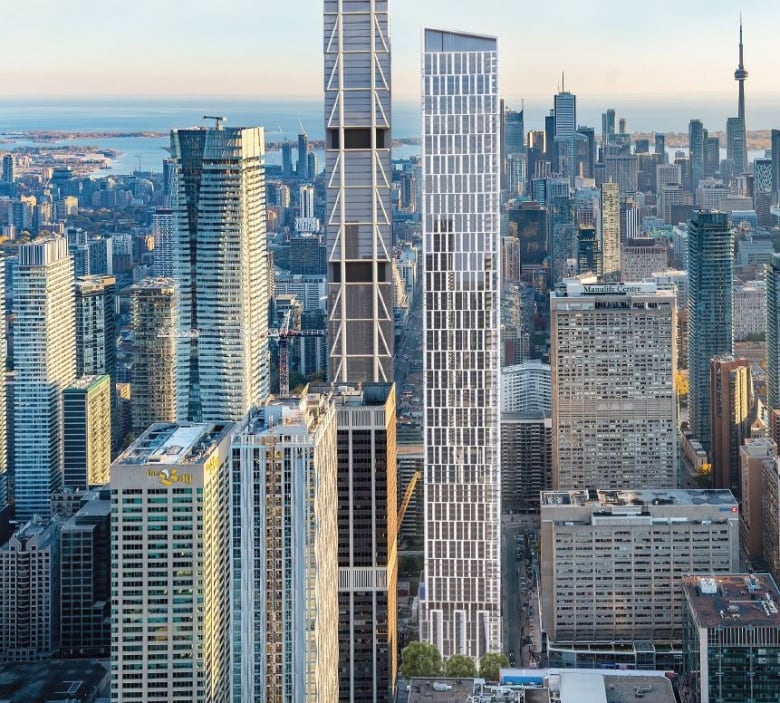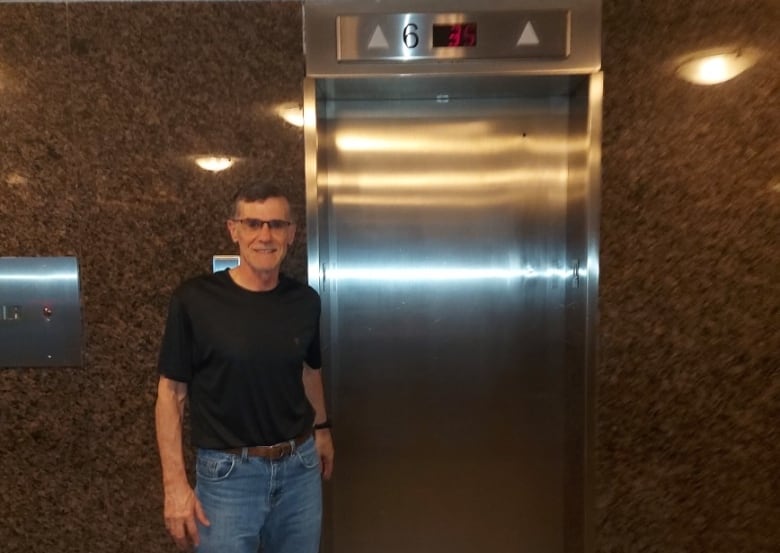Supertall buildings mean Toronto needs new elevator rules: experts
U of T prof, elevator consultant say wait times can affect quality of life

Some experts are cautioning that supertall buildings planned for Toronto could come with long elevator wait times unless new rules are passed.
And long wait times, they say, can affect quality of life.
"We're putting a lot of our bets on these very tall buildings, particularly right around subway stations. And yes, higher density is needed," Eric Miller,director of the University of Toronto Transportation Research Institute, told CBC's Metro Morningthis week.
"But I think we have to be much more thoughtful about how we're providing the housing and whether 80-storey apartment buildings are the solution when you look at the entire kind of day-in-the-life of these people."
In March, Toronto city council voted to accept a settlement offer for a supertall building at 15 to 19 Bloor St. W. According to a lawyer's letter attached to council's decision, the building willbe 99 storeys and 317metres, making it oneof a growing number of supertall buildings planned in Toronto.
The Council on Tall Buildings and Urban Habitat, a non-profit organization for people interested in the future of cities, says a "supertall" building stands at least 300 metres, while a "megatall" building is at least 600 metres.
According to the city, the 15 to 19 Bloor St. W. development has yet to beapproved by the Ontario Land Tribunal. The city has directed the city solicitor to attend thetribunalhearing tosupport the settlement. Its next meeting is July 12.

Reserve Properties, one of two developers involved in the project, did not specify in a statement to CBC Toronto how many elevators will be in the building. The other developer of the property is Westdale Properties.
"Once we have locked in approvals on height and massing, we will turn our attention to designing the interiors of the building and that will include adjusting the number of units and elevators. This is a project that is still in the rezoning process, and we fully expect the interior design to change as we work through additional approvals, sales and marketing, and ultimately construction," the statement reads in part.
Urban Toronto,an online forum and news site that tracks development in southern Ontario, says in an April 3article about the development:"Both the initial and revised proposals feature eight elevators. In the initial plan with 1,262 units, this makes approximately one elevator for every 158 units. The revised plan has 1,290 units, altering the ratio to about one elevator for every 161 units, among the highest we have seen in recent proposals, and indicating potentially prolonged wait times."
Standard for elevator wait times is 45 to 50 seconds
Rob Isabelle, chief operating officer of elevator consulting company KJA, said the global standard for elevator wait times is 45 to 50 seconds. He helps developersfigure out how many they need.

If there is one elevator for every 160 units in a supertall building with about 1,280 units, the quality of service willbe problematic, he said.
"People on a regular basis, with all elevators operational, would likely wait two minutes, three minutes, four minutes for an elevator regularly," Isabelle said.
"And the problem is, of course at the end of the month, there's always going to be one that's going to be used to move people in and out. You're down one elevator so the three minutes becomes five minutes, becomes six minutes. And to wait for an elevator for six minutes, it feels as if you're waiting for half an hour," he said.
According to Isabelle, Ontario's Building Code does not specify a minimum number of elevators required in residential buildings of a certain size or outlinerequirements related to elevator wait times.
The city, for its part, said the building coderegulates the provision of elevators in buildings for the purposes of barrier-free access and firefighting in certain high-rise buildings. The number of elevators, however,is not regulated through the city's zoning bylaw.
Ontario's Ministry of Municipal Affairs and Housing did not respond to a request for comment.

For Miller, wait times are a quality of life issue. He considers elevators a mode of vertical transportation and says the time spent waiting for one is especiallyonerous because it's repeated every time someone leaves their unit.
"It's a stress.Will the elevator come? What we're doing is lowering the quality of life of people. This is a price people are paying day after day," he said. "And nobody thinks about that."
Miller added that governments should look more closely atissues affecting vertical transportation, developguidelines for acceptable elevator wait timesin residential buildings and determinehow many elevators areneeded to meet demand in buildings of different sizes.
There's no consideration of elevator wait times in the provincial building code ormunicipal development approval processes, he said, and residents often don't think about the issueuntil they have moved in.

Elevators 'down every other week,' resident says
For one resident of a recently built highrise, elevator wait times area daily problem.
"They're down every other week, pretty much. It's actually pretty unbelievable," said William Brown.
Sometimes there are lineups in the lobby of the Adelaide Street building, which is less than a decade old,and residents have even posted on a private Facebook group, advising others to avoid coming home when there are bottlenecks, he said.
"They've sent out emails a couple of times saying people have to take the stairs but it's a 43-storey building," Brownsaid. "Luckily, I'm only on the 16th floor so it's not too bad and I'm still fairly young."












_(720p).jpg)


 OFFICIAL HD MUSIC VIDEO.jpg)
.jpg)



























































































